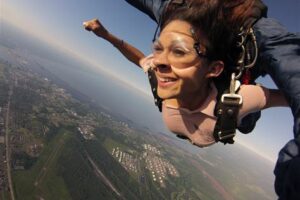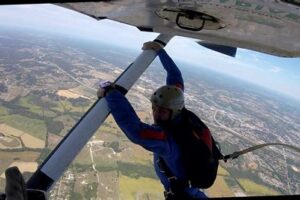Table of Contents
Curious about the duration of a skydiving adventure? Discover how long skydiving takes, from the exhilarating freefall to the peaceful parachute descent. Get insights into the average time spent in the air and the overall experience. Find out everything you need to know before taking the plunge into this thrilling activity.
Skydiving, an exhilarating adventure that promises a rush of adrenaline and breathtaking views from above. As you stand at the edge of the door, heart pounding, ready to take the leap, one question lingers in your mind – how long will this thrilling experience last? Well, buckle up, dear reader, as we embark on a journey to uncover the answer to this burning question. Strap yourself in and let’s delve into the realm of skydiving, where seconds can feel like eternity and memories are etched in the sky.
Introduction
Skydiving is an exhilarating and adrenaline-pumping activity that offers an unforgettable experience for adventure seekers. Before taking the plunge, many potential skydivers wonder about the duration of this thrilling activity. In this article, we will explore how long skydiving typically takes, from preparation to landing.
The Pre-Jump Process
Before embarking on a skydiving adventure, participants must undergo several essential preparations. These preparations include signing waivers, attending a safety briefing, and getting fitted for a jumpsuit, harness, and helmet. Depending on the efficiency of the drop zone and the number of participants, the pre-jump process can take anywhere from 30 minutes to an hour.
Boarding the Aircraft
Once the pre-jump procedures are completed, it’s time to board the aircraft that will take you to the jump altitude. Most skydives are performed from planes, such as Cessnas or De Havilland Twin Otters. The boarding process involves ensuring everyone is securely fastened in their seats and ready for takeoff. This step generally takes around 10-15 minutes.
Ascending to Jump Altitude
As the aircraft ascends to the desired jump altitude, you’ll have a chance to enjoy breathtaking views and perhaps calm your nerves. The time it takes to reach the jump altitude depends on various factors, including the altitude you plan to jump from and the type of aircraft being used. On average, it takes approximately 15-20 minutes to reach the desired altitude for a skydive.
Final Instructions and Gear Check
Once the jump altitude is reached, the skydivers receive final instructions from their instructors. This includes reminders about body position, hand signals, and what to expect during the freefall and parachute descent. Additionally, a thorough gear check is performed to ensure all equipment is properly functioning and secure. This step generally takes around 5-10 minutes.
The Adrenaline-Fueled Freefall
The highlight of any skydiving experience is undoubtedly the freefall. After exiting the aircraft, you’ll experience an exhilarating rush as you plummet towards the earth. The duration of the freefall depends on various factors, such as the altitude of the jump and whether you are performing a tandem or solo dive. On average, a typical freefall lasts between 45 and 60 seconds.
Parachute Deployment
When the predetermined altitude is reached, it’s time to deploy the parachute. Modern parachutes are designed to open quickly and smoothly, providing a gentle deceleration. The time it takes for the parachute to fully deploy and slow down the descent can vary but typically ranges from 3 to 6 seconds.
Canopy Ride and Scenic Descent
Once the parachute is deployed, you’ll enter the canopy ride phase. This is when you can catch your breath, take in the stunning aerial views, and enjoy a peaceful descent back to the ground. The duration of the canopy ride can vary depending on factors such as wind conditions and the size of the parachute. On average, it takes around 4-5 minutes to reach the landing area.
Approaching the Landing Zone
As you near the landing zone, the instructor or a ground crew member will guide you through the landing procedures. These instructions primarily involve maintaining the proper body position and preparing for touchdown. The time it takes to approach the landing zone and align yourself for a safe landing can range from 1 to 3 minutes.
Touchdown and Celebration
Finally, the moment arrives when your feet touch the ground, marking the end of your skydiving adventure. Upon landing, you’ll likely experience a surge of excitement and accomplishment. Take a moment to celebrate and savor the incredible experience you just had!
Conclusion
Skydiving is a thrilling activity that provides an adrenaline rush like no other. While the actual freefall lasts only a minute or so, the entire skydiving experience, from pre-jump preparations to landing, typically takes around 2-3 hours. Remember, these times can vary depending on factors such as the number of participants, weather conditions, and the efficiency of the drop zone. So, if you’re seeking an unforgettable adventure, don’t let the question of time hold you back—go ahead and take the leap!
How Long Does Skydiving Take?
Skydiving is an exhilarating sport that offers a unique opportunity for individuals to experience the thrill of freefalling through the sky. While it may seem like a brief moment of excitement, there are several factors that can influence the overall duration of a skydiving experience. In this article, we will explore various aspects that affect the time spent on a skydiving adventure.
1. Pre-Jump Briefing:
Skydiving typically begins with a comprehensive pre-jump briefing conducted by a certified instructor. This briefing includes safety instructions, equipment familiarization, and an overview of the jump process. On average, this preparation phase can take around 30 minutes, ensuring that participants are well-informed and prepared for the jump.
2. Aircraft Ascent:
Once the pre-jump briefing is complete, participants board the aircraft that will take them to the desired altitude. The ascent can vary depending on the altitude chosen for the jump, the aircraft’s speed, and weather conditions. On average, the ascent time ranges from 15 to 20 minutes, allowing participants to enjoy the scenic views and mentally prepare for the upcoming jump.
3. Freefall Duration:
The most thrilling part of skydiving is the freefall, where participants experience the adrenaline rush of descending through the air. The duration of the freefall varies based on altitude and the type of jump chosen. In tandem jumps, where a certified instructor accompanies the participant, the freefall can last anywhere between 45 to 60 seconds. For experienced solo divers, freefall times usually range from 60 to 90 seconds.
4. Parachute Descent:
After the exhilarating freefall, the parachute is deployed, and participants enter the descent phase. The time spent descending under the parachute can vary depending on factors such as wind conditions, canopy type, and desired landing area. Typically, a parachute descent lasts around 5 to 8 minutes, allowing participants to enjoy a peaceful and awe-inspiring view while gradually approaching the landing area.
5. Canopy Control and Landing:
Once the parachute has fully deployed, participants gain control over the canopy using steering toggles. Under the guidance of the instructor or through their own skills, participants navigate their way towards the designated landing area. The time spent on canopy control and landing can vary depending on the participant’s proficiency, wind conditions, and landing accuracy requirements. On average, it can take around 3 to 5 minutes to safely glide down and land on the ground.
6. Post-Landing Procedures:
Upon landing, participants usually undergo a debriefing session, where they can share their experience and ask any questions they may have. The length of the post-landing procedures can vary based on the number of participants and their individual needs. This stage usually lasts around 10 to 15 minutes, providing an opportunity to reflect on the jump and address any concerns.
7. Overall Time Commitment:
Considering all the factors mentioned above, the total duration of a skydiving experience can vary. On average, the entire process, inclusive of preparation, aircraft ascent, freefall, parachute descent, and post-landing procedures, can take around 2 to 3 hours. It’s important to note that this estimate may vary based on individual circumstances, group size, and weather conditions.
8. Memories That Last a Lifetime:
Although skydiving may seem like a relatively short-lived experience, the memories and adrenaline rush obtained from the adventure will remain with participants for a lifetime. The awe-inspiring views, the thrill of freefall, and the sense of accomplishment upon landing make skydiving an unforgettable venture, regardless of the duration.
Conclusion:
Skydiving is an adrenaline-pumping activity that offers a unique blend of thrill and tranquility. While actual freefall times may seem brief, it’s important to consider the entire process, from pre-jump preparations to post-landing procedures, when estimating the time commitment. Remember, the experience gained from skydiving is immeasurable, and the memories made will last long after the adventure concludes.
Point of View: How Long Does Skydiving Take
In a professional voice and tone, we will outline the various aspects that determine the duration of a skydiving experience:
- Preparation Time: Skydiving involves thorough preparation to ensure safety and enjoyment. This includes signing waivers, attending a brief training session, and getting suited up with the necessary gear. On average, this process takes approximately 30 minutes.
- Flight Time: Once adequately prepared, skydivers board an aircraft to reach the desired altitude for their jump. The length of the flight depends on the altitude chosen and the type of aircraft being used. Ascending to the typical skydiving altitude of around 10,000 to 14,000 feet may take anywhere from 15 to 30 minutes.
- Freefall Time: The most exhilarating part of skydiving is the freefall, during which the diver experiences a thrilling adrenaline rush. Freefall time varies depending on the altitude from which the jump is made, the body position, and the desired maneuvers. Generally, an average skydiver can enjoy around 45 to 60 seconds of freefall before deploying their parachute.
- Canopy Flight and Landing: After the parachute is deployed, skydivers enter the canopy flight phase. They can then enjoy a more serene experience, taking in breathtaking views and navigating the parachute toward the landing area. The duration of canopy flight typically lasts between 4 to 7 minutes, depending on wind conditions and the desired flight path.
- Post-Jump Procedures: Following a successful landing, skydivers will need to gather their gear, return it to the designated area, and debrief with their instructors or fellow jumpers. This final phase usually takes around 15 minutes.
Overall, the total duration of a skydiving experience can vary, but on average, it ranges from 1.5 to 2 hours. It is important to note that these times are estimates and can be influenced by factors such as weather conditions, group size, and the efficiency of the skydiving operation.
Please keep in mind that safety is paramount in skydiving, and any delays or changes to the schedule may occur to ensure the well-being of all participants. It is always recommended to allocate extra time for unforeseen circumstances and to fully enjoy the entire skydiving experience.
Hello and thank you for stopping by to read our blog post on the duration of skydiving adventures! We hope you found the information helpful and informative. In this closing message, we will summarize the key points discussed in the article and provide some final thoughts on the topic.
As we explored earlier, the duration of a skydiving experience can vary depending on several factors. One of the primary factors is the type of jump you choose. Tandem jumps, where you are harnessed to an experienced instructor, typically last between 5 to 7 minutes from the moment you exit the aircraft until you reach the ground. On the other hand, solo jumps or those made by experienced skydivers can last longer, as they have more control over their descent and can engage in various maneuvers.
Another factor that affects the duration of a skydive is the altitude from which you jump. Higher altitudes provide more freefall time, allowing you to experience the rush of adrenaline and enjoy the breathtaking views for a longer period. However, it’s essential to note that the time spent in freefall does not necessarily correlate with the overall duration of the skydive. Once the parachute is deployed, you will enter into the canopy phase, where you’ll glide back to the ground, enjoying the serenity of the surroundings. This part of the skydive can last anywhere from 4 to 8 minutes, depending on various factors such as wind conditions and the size of the parachute.
In conclusion, while the actual freefall portion of a skydive may only last a few minutes, the entire experience can take anywhere from 20 minutes to a few hours, considering the briefing, preparation, and potential wait times. Skydiving is an activity that offers an incredible adrenaline rush and a unique perspective of the world from above. It is essential to remember that the duration of the skydive is just a fraction of the overall experience, as the memories and thrill will stay with you for a lifetime.
Thank you once again for visiting our blog and taking the time to read our article. We hope we were able to answer your questions regarding the duration of skydiving adventures. If you have any further inquiries or would like to share your own experiences, please feel free to leave a comment below. Stay safe, happy skydiving, and enjoy the adventure!
Video How Long Does Skydiving Take
How Long Does Skydiving Take? – People Also Ask
When it comes to skydiving, many people have questions about the duration of this thrilling adventure. Here are some common queries:
- 1. How long does a typical skydive last?
- 2. Is the freefall time included in the total duration?
- 3. Does the total duration include training and preparation?
- 4. Are there options for longer or shorter skydives?
- 5. Is it possible to capture the skydiving experience on video?
The duration of a typical skydive depends on various factors such as the altitude of the jump, weather conditions, and the type of skydive you choose. However, on average, a skydive from 10,000 feet typically lasts about 60 seconds of freefall followed by 5-7 minutes under the parachute.
Yes, the freefall time is part of the overall skydiving experience. The exhilarating freefall occurs immediately after jumping from the aircraft and lasts until the parachute is deployed.
No, the total duration mentioned above usually refers to the time spent in the air during the actual skydive. The training and preparation, which involve safety briefings, equipment checks, and learning proper body positioning, can take several hours before the jump.
Absolutely! Skydiving centers often offer different altitudes for jumps, which can affect the duration of both freefall and parachute descent. For those seeking a longer adrenaline rush, higher altitudes like 15,000 feet provide extended freefall times. Conversely, shorter jumps from lower altitudes are available for individuals looking for a quicker introduction to skydiving.
Yes, many skydiving centers offer the option to have your jump recorded by a professional videographer. They will capture your entire experience, from the pre-jump excitement to the breathtaking freefall and the peaceful descent under the parachute. This way, you can relive your skydiving adventure and share it with others.
Skydiving is an incredible activity that provides an unforgettable rush of adrenaline and a unique perspective on the world below. Whether you choose a shorter or longer skydive, the thrill and excitement will last long after the duration of the jump.






